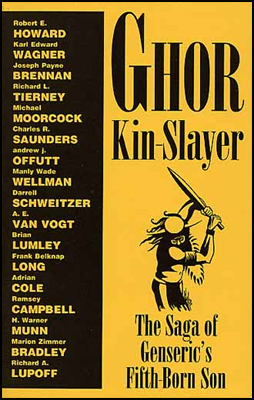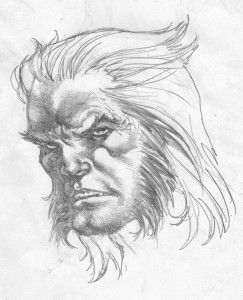Ghor, Kin-Slayer: A Look Back
Wednesday, May 13, 2009
posted by Deuce Richardson
 Print This Post
Print This Post
 Sometime in the late 1970s, the Rev. Jonathan Bacon (a one-time member of REHupa) came up with a fairly cool idea. Bacon was the editor of Fantasy Crossroads, a Howard-centric fanzine. Through Glenn Lord, Bacon had acquired the Robert E. Howard fragment, “Genseric’s Fifth-Born Son” (the title derives from Lord, as far as I can ascertain), a part of the “James Allison” series of reincarnation tales. Bacon thought it would be interesting to bring together many of the active fantasy authors at that time and have them “complete” Howard’s fragment in a round-robin fashion. Robert E. Howard himself had participated in something similar when he wrote a chapter for “The Challenge From Beyond,” a round-robin tale published by the fanzine Fantasy Magazine in late 1935. In some ways, Bacon was just following a trail that REH had helped blaze. However, he chose to discard the Lord title for the fragment as a title for the entire work, deciding upon Ghor, Kin-Slayer as being a better designation.
Sometime in the late 1970s, the Rev. Jonathan Bacon (a one-time member of REHupa) came up with a fairly cool idea. Bacon was the editor of Fantasy Crossroads, a Howard-centric fanzine. Through Glenn Lord, Bacon had acquired the Robert E. Howard fragment, “Genseric’s Fifth-Born Son” (the title derives from Lord, as far as I can ascertain), a part of the “James Allison” series of reincarnation tales. Bacon thought it would be interesting to bring together many of the active fantasy authors at that time and have them “complete” Howard’s fragment in a round-robin fashion. Robert E. Howard himself had participated in something similar when he wrote a chapter for “The Challenge From Beyond,” a round-robin tale published by the fanzine Fantasy Magazine in late 1935. In some ways, Bacon was just following a trail that REH had helped blaze. However, he chose to discard the Lord title for the fragment as a title for the entire work, deciding upon Ghor, Kin-Slayer as being a better designation.
A more complete account of how Bacon strove to get all chapters of the collaboration he envisioned published is told elsewhere. It suffices to say that only twelve out of seventeen chapters ever saw print in Fantasy Crossroads, the last being in January of 1979.
Jonathan Bacon then dropped off the map. However, Glenn Lord still retained a complete manuscript of all seventeen chapters. Nearly twenty years later, March Michaud of Necronomicon Press, learning of the complete manuscript, decided that he would publish the entire round-robin tale. Utilizing the editing talents of Rusty Burke, Michaud got Ghor, Kin-Slayer published in August, 1997. I received my copy in early 1998.
Ghor, Kin-Slayer is a chimerical beast, no way around it. The contributors to the tale range from Karl Edward Wagner and Charles R. Saunders to A. E. Van Vogt and Marion Zimmer Bradley. I intend to examine the whole story on a chapter-by-chapter basis. For those of you who tend toward spoiler-phobia, I suggest you stop reading right about now.

“Chapter I: Genseric’s Son” by Robert E. Howard
Howard provides an excellent foundation for the “round-robin.” The tale begins in the eternal snows of Vanaheim, where the crook-legged fifth-born infant son of Gudrun is, literally, thrown to the wolves. James Allison reveals that the child would later become known as Ghor the Strong among the Æsir. REH also implies that Allison is relating this particular tale from his death-bed.
“Chapter II: The Coming of Ghor” by Karl Edward Wagner
This chapter showcases some of Wagner’s better writing. It is filled with the “blood and hate” that de Camp derided in regards to KEW’s fiction, but which is so appropriate for this tale. Ghor grows to manhood as a member of a wolf-pack. Wagner intimates that there is some sort of “were-wolf” lineage in the blood of Genseric’s son. The red-headed Ghor joins a band of Æsir (parallels to Wagner’s “Reflections for the Winter of My Soul” are ironic, indeed). He then, unknowingly, kills his father in battle. Subsequently, he learns the story of his outcasting and the names of his mother and four brothers.
“Chapter III: Ghor’s Revenge” by Joseph Payne Brennan
Long story short: Ghor tracks down all five of his surviving relatives and kills them. I am a fan of JPB’s fiction, but I am compelled to agree with Rusty Burke that Brennan totally short-circuited the plot that KEW set up in the preceding chapter. The hunt that might have constituted an entire novelet is compressed and short-changed by Brennan. Also, JPB depicts Nordheim as a faux Scandinavia, complete with fir trees (a conceit carried forward into later chapters). This vision of Vanaheim and Asgard is contradicted by every single description given us by Robert E. Howard.
“Chapter IV: The Ice-Woman’s Prophecy” by Richard L. Tierney
Things really start to go off the rails in this chapter. Tierney has Ghor visited by “Ythillin,” an Atali-esque messenger of the “Ice Gods.” Forgetting the fact that the only god (to judge from “The Frost-Giant’s Daughter” and nearly all of the “Allison” yarns) that the Nordheimr render reverence to is Ymir, the worst thing about this chapter is that “Ythillin” (what sort of Nordheimr name is that, by the way?) delivers a prophecy unto our wolfish hero. No more free wandering and carnage for lupine Ghor. Oh no. Tierney railroads him into saving Nemedia. Apparently, the “Ice Gods” of Nordheim give a good “Ice God”-damn as to what happens to a particular Hyborian nation (Ythillin specifically mentions saving Nemedia’s civilization). Seemingly, Ghor’s adopted tribe of Æsir is supposed to correspond to the one which bolsters Nemedia in its final days, as mentioned in the “Hyborian Age” essay. However, the reason as given by Howard (and the same reason given in all other “Allison” stories) is wander-lust, not some divinely commanded emigration.
“Chapter V: The Nemedians” by Michael Moorcock
The less said about this chapter, the better. I’ll note that MM totally throws any of Howard’s well-established naming conventions right out the skalli-door. Oh yeah, and he introduces “Snow Camels” (Moorcock’s capitalization) to the list of Hyborian Age fauna. Moorcock trots out the hackneyed plot-device of saving a princess. As far as I know, this was Moorcock’s first and only attempt at writing a “barbarian” character. If anyone needs further evidence that Moorcock could not/cannot write Howardian pastiche, here is the proof.
“Chapter VI: Betrayal in Belverus” by Charles R. Saunders
This chapter is very well-written, as one would expect from a master of Sword-and-Sorcery such as Mr. Saunders, but it is crippled by the ill-thought and ill-wrought ideas of the contributors in preceding chapters.
“Chapter VII: Lord General of Nemedia” by andrew j. offutt
Decently written. Ghor’s love (“Shanara,” introduced by Moorcock) is taken away to Turan. Who’d’ve thunk it?
“Chapter VIII: The Oath of Agha Junghaz” by Manly Wade Wellman
Beforehand, I’d like to state that I’m an MWW fan. That said, while this chapter isn’t bad, it could have been better. Wellman inexplicably makes the Turanians Set-worshippers. However, there is some good repartee and action, here and there. Read Wellman’s Cahena for something much better.
“Chapter IX: The Mouth of the Earth” by Darrell Schweitzer
Schweitzer authored the much- (and justly) maligned, Conan’s World and Robert E. Howard. However, I have the courage to state that I find Schweitzer’s The Mask of the Sorcerer to be a worthy novel. That said, this chapter is execrable.
“Chapter X: The Gods Defied” by AE Van Vogt
Can someone please explain to me why Jonathan Bacon felt it necessary for this author to contribute? Was Van Vogt even a fan, of any kind, of Robert E. Howard?
“Chapter XI: Swordsmith and Sorcerer” by Brian Lumley
In this chapter is introduced the plot element of the “magical sword of Genseric.” As if Tierney’s prophecy wasn’t enough. I will say that I’d rather see Lumley write Howardian pastiches over Moorcock or Van Vogt.
“Chapter XII: The Gift of Lycanthropy” by Frank Belknap Long
Surprisingly, in the Hyrkanian cluster that this round-robin had become, FBL turns in an almost respectable chapter. Considering that this is the same literary titan who once called REH’s fiction (at least the Conan yarns) “boys’ stories,” I am curious as to whether Long had a change of heart at a late date, or if he was just whoring himself out for some reason.
“Chapter XIII: The War Among the Gods” by Adrian Cole
While I’m a fan of Cole’s, this chapter is only readable. The accumulation of ill-conceived plot-devices left him little room to maneuver, perhaps.
“Chapter XVI: The Ways of Chaos” by Ramsey Campbell
Campbell attempts to salvage his chapter by focusing upon Ghor’s struggles against Stygians and Hyrkanians, with a dose of the Mythos thrown therein. A good chapter.
“Chapter XV: The Caves of Stygia” by H. Warner Munn
There are those who seem to find goodness in Munn’s prose. I’ve yet to do so. He certainly tried to cram as many extraneous Mythos references into his chapter as possible. I will give him that.
“Chapter XVI: Doom of the Thrice-Cursed” by Marion Zimmer Bradley
Was MZB a Howard fan (see Chapter X)? That said, this chapter is not badly written, to my surprise.
“Chapter XVII: The River of Fog” by Richard A. Lupoff
This final chapter is utterly ridiculous. It also shows definite signs of Lupoff never reading any other tales in the “Allison” series.
*********
Could Ghor, Kin-Slayer have turned out better? I certainly think so. If Bacon had appointed Wagner as “team captain,” the entire enterprise might have gone in an excellent direction. Strictly adhering to the round-robin principle does not seem to have served Ghor, Kin-Slayer very well. While not naming names, I will say that I feel it would’ve been better if fewer authors had written more chapters. Also, where were Poul Anderson, [redacted] and David Drake in all of this?
Ghor, Kin-Slayer is almost a perfect microcosm of the entire history of Robert E. Howard pastiches. The adage of “garbage in, garbage out” would certainly apply to this “round-robin.” One bad idea, demonstrably contrary to Howard’s practices or intent, leads to another. In a relative eyeblink, the story (or saga) becomes something that the Man From Cross Plains would have never recognized as springing from his gifted brow.
*Art by Staz Johnson
